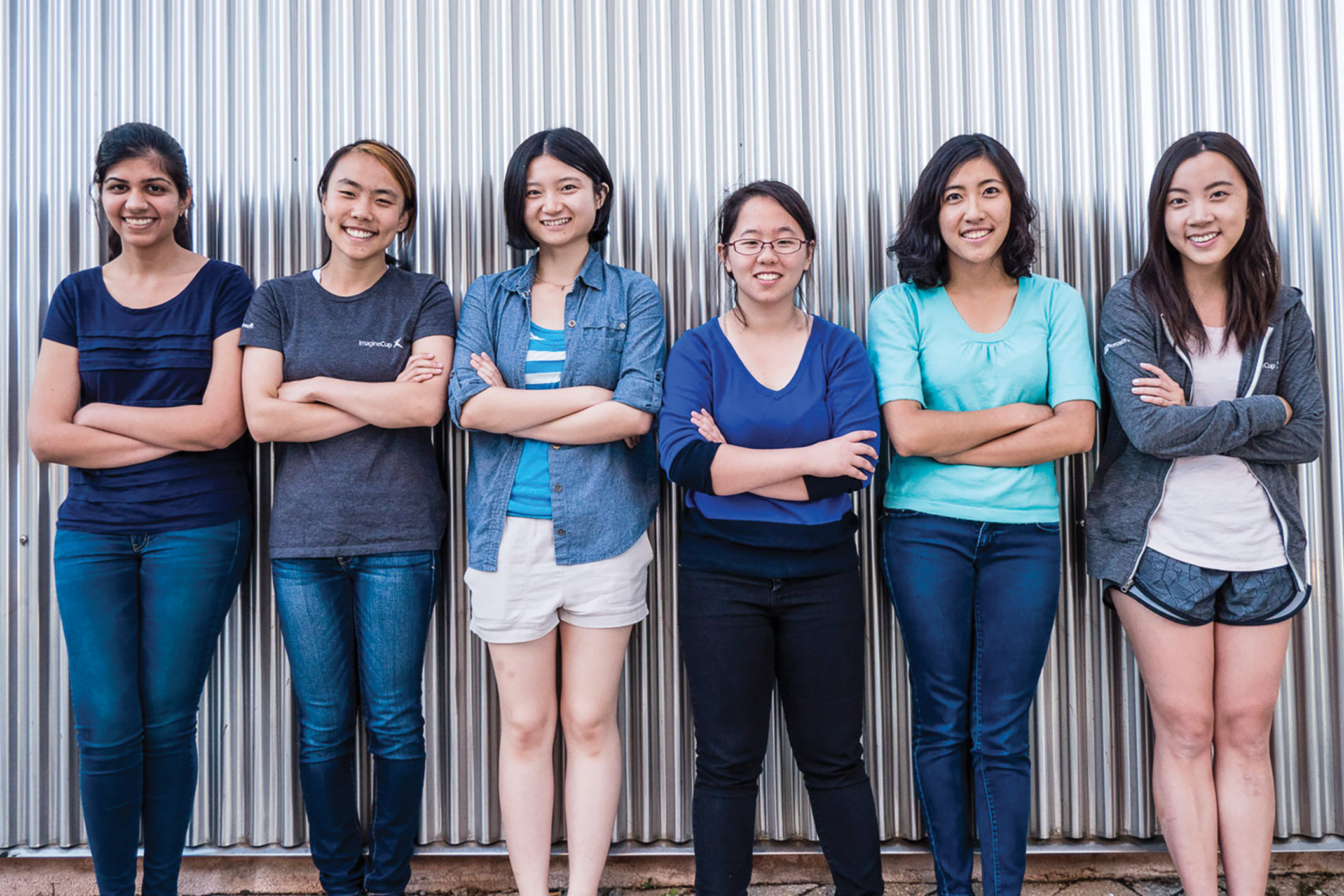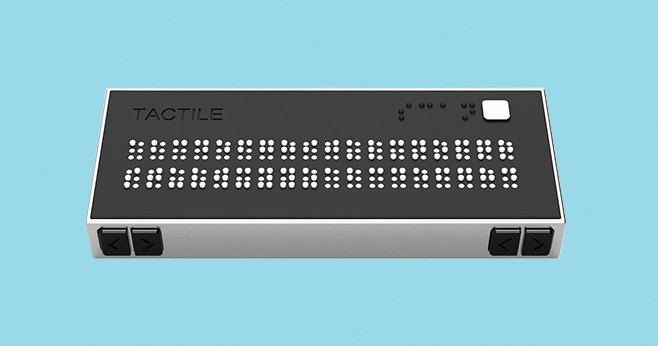MIT Students Invent Simple Device that Makes Printed Text Accessible to the Blind

At 7:45 a.m. on the day before Valentine’s Day 2016, five undergrads gathered at the Stratton Student Center to take part in the annual MakeMIT hackathon. The women, who’d been friends since their freshman year, called themselves “Team 100% Enthusiasm.” While brainstorming before the hackathon about what to build, they’d considered dancing robots and exceptionally startling alarm clocks. But then Jialin Shi ’17 mentioned an article she’d seen about a Braille watch, prompting Chandani Doshi ’17 to tell her teammates about the blind students she’d worked with while helping test educational apps in Delhi one summer. The students had been enthralled by Doshi’s laptop, despite having to count keys in order to type a message.
“At that point, all the other ideas floating around vanished,” Shi says. “We narrowed it down to making something Braille, something that could help visually impaired individuals.” After 15 grueling hours of construction at the hackathon—and just three minutes before time ran out at 12:30 a.m.—the group emerged with a bulky device able to detect the letter L and render it in Braille by moving six protruding pins. The concept, called Tactile, secured first place and a Microsoft sponsorship. And having built a proof of concept, Team 100% Enthusiasm officially morphed into Team Tactile.
Over the next three months, Team Tactile began developing a more robust prototype, made the finals of Microsoft’s Imagine Cup, landed an MIT IDEAS Global Challenge grant, and got additional support from the MIT Sandbox Innovation Fund Program. The teammates also added a sixth member (the hackathon had only permitted teams of five), giving them a good mix of engineering skills to bring the concept to life: three are mechanical engineers, two are electrical engineering and computer science majors, and one is a materials science engineer.
All Braille translator devices currently on the market cost between $2,000 and $5,000. Team Tactile aims to make its device for just $100.
The current iteration of the device, which is about the size of three iPhones stacked together, features sets of six raised bumps on the top and a miniature camera on the bottom. The final product will constitute the first affordable handheld text-to-Braille converter. The device “lifts” printed letters from paper in the time it would take to flip a page, raising and lowering pins to form Braille characters.
Although apps that translate text to audio are available, Tactile can be used in situations where audio isn’t appropriate, Doshi explains—“For instance, during a meeting or somewhere in public when it’s more convenient to read rather than hear the translation.” And while devices that convert electronic documents to Braille also exist, Team Tactile is aiming to provide affordable access to the printed writing in everyday life that’s not electronic, including papers, menus, flyers, labels, bills, and books that aren’t available online.
The one existing handheld device that can translate printed text to Braille renders only 20 Braille characters at once. What’s more, that device and others that can translate electronic text to Braille are not cheap: all the devices currently on the market cost between $2,000 and $5,000. “The blind adult unemployment rate is up around 70 percent, so many can’t afford those figures,” says Paul Parravano, co-director of the Office of Government & Community Relations and one of Team Tactile’s MIT mentors, who is a longtime Braille reader.
By contrast, Team Tactile plans to offer a generous character count in a device that’s both compact and affordable. While Tactile’s current prototype contains just six cells (and thus communicates six letters at a time), the final product is expected to include two rows of 18 cells, for a total of 36 characters. The team aims to be able to manufacture its device for just $100.

A low-cost converter could make Braille more accessible. Out of the 1.3 million Americans who are legally blind, fewer than 10 percent are literate in Braille. In fact, an estimated 90 percent of the nation’s blind children are never taught Braille or lack access to it altogether.
Charlene Xia ’17 notes that part of the reason existing devices are so expensive, and in some cases bulky, is the antiquated nature of the existing technology. “Nobody’s thought to update it,” she explains. “We’re proposing a new mechanism that will lower the cost.”
Most refreshable Braille displays use piezoelectric actuation mechanisms to move the pins that generate the bumpy patterns denoting each letter. “There are a limited number of companies that produce these Braille cells,” team member Grace Li ’17 says. “So there’s a lack of competition, which drives up the cost.” Such cells also require continuously applied voltage to move the pins up and down.
Team Tactile is investigating alternative mechanisms that use less expensive materials and require less power to control pin movement—perhaps relying on microfluidics or magnets. And that investigation has been an education in itself. “I’ve had the opportunity to do back-of-the-envelope calculations, drill holes in aluminum, and try all these hands-on aspects of materials science that I hadn’t been exposed to before,” Chen (Bonnie) Wang ’17 says.
Ultimately, they’re aiming for a 6-by-3-by-1-inch product with a camera on the underside to capture a picture of text, which will then be sent to a cell-phone app via Bluetooth. The first 36 characters will be extracted from the image, converted to Braille, and relayed back to the device, where the individual pins will move up or down to form the letters, discernible by touch. A yet-to-be-determined feedback system (perhaps a vibration or an auditory cue) will indicate whether the text was successfully detected or if the device should be rotated to capture it properly. The user will be prompted to press the panning button to refresh the Braille display and receive the next 36 characters if there are more in the image, or to shift the device down the page to scan and interpret the next block of text.
The mobile app takes advantage of a smartphone’s powerful processor and Wi-Fi capabilities. It also allows information to be stored on the phone and accessed later. Although the group is devising its own app, Tactile could function in tandem with third-party software as well.
With some help from Microsoft’s #MakeWhatsNext Patent Program, which offers pro bono legal support to teams containing at least one woman, Tactile patents are under review in the U.S. and India. “I didn’t realize how male-dominated the patent industry was,” says Li, who was surprised to learn that although women have more than quintupled their representation among U.S. patent holders since the late 1970s, fewer than 20 percent of all U.S. patents listed even one female inventor in 2010. “We feel very strongly that we want to be role models for young girls interested in STEM.”
The six have been approached by manufacturing companies and NGOs interested in their design—and they’ve reached out to some others—but Team Tactile won’t make any determinations until the product has been fully developed. As the March deadline “to make life decisions” (as Xia put it) approached, all the teammates had already committed to continue working on developing Tactile for some period of time after they graduate in June. In the meantime, Tactile has already given team members an opportunity to apply knowledge gleaned in the lab and classroom to the world beyond MIT. Says Xia, “You can work on a problem set for school, or you can work on something that may make a difference.”
Keep Reading
Most Popular
Large language models can do jaw-dropping things. But nobody knows exactly why.
And that's a problem. Figuring it out is one of the biggest scientific puzzles of our time and a crucial step towards controlling more powerful future models.
The problem with plug-in hybrids? Their drivers.
Plug-in hybrids are often sold as a transition to EVs, but new data from Europe shows we’re still underestimating the emissions they produce.
How scientists traced a mysterious covid case back to six toilets
When wastewater surveillance turns into a hunt for a single infected individual, the ethics get tricky.
Google DeepMind’s new generative model makes Super Mario–like games from scratch
Genie learns how to control games by watching hours and hours of video. It could help train next-gen robots too.
Stay connected
Get the latest updates from
MIT Technology Review
Discover special offers, top stories, upcoming events, and more.